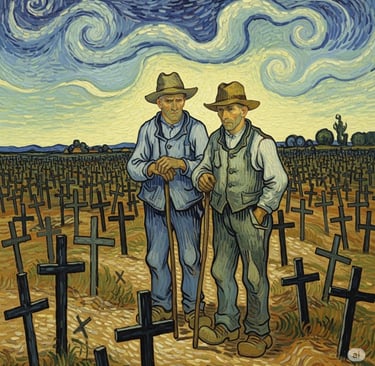An Ancient Transylvanian Spell against Revenants
This is an incantation collected over a century ago in western Transylvania.
7/30/20253 min read


A Spell Against the Undead
We now turn to a spell once used to rid the world of revenants—an incantation collected over a century ago in western Transylvania by the folklorist E. Hodos. In the introduction to the book he published in 1905, Hodos described the distinction between charms and spells.
What Are Spells or Charms?
According to Hodos: "They consist of a ceremony performed by a person who, in the eyes of the people, can do whatever he wishes—someone typically in contact with unclean spirits, but who knows how to control and command them. The power of a spell is expressed in the gestures of this being and in the objects he uses when casting. If words are spoken during the ritual, and they follow a particular rhythm or cadence, then the ceremony is accompanied by magic."
One can cast a spell without speaking a charm—but true enchantment requires bewitchment. An example of a spell without a charm can be found in this rite collected in Banat. In this ritual, two sorcerers conduct the entire ceremony to deliver a villager from an undead tormentor while uttering only a few clumsy, half-formed verses.
In rural communities, the wizard was both feared and revered—not so much for his malice as for his mysterious power. People fear him, yes, but they also admire him, seek his aid, and avoid him only when they can afford to. Because witchcraft has long been persecuted by the authorities, practitioners often deny their true role. They say they do not “charm,” only “enchant” in order to “untie” or “unbind”—a practice permitted even by the Church, which has its own “unbinding prayers.”
So, this is it: A Transylvanian Revenant-Binding Spell.
When a man is tormented by a revenant—one who rises nightly from the grave to haunt the living—he calls upon two wizards. After nightfall, the sorcerers begin by searching the house, checking barrels, pots, and other containers for any sign of the creature. If they find nothing, they proceed to the revenant’s grave.
As they leave the afflicted household, they exchange the following chant:
First Sorcerer: "Chaka, maka!"
Second Sorcerer: "Barikaka!"
They repeat this call three times, then head to the cemetery, carrying with them a sleeve from a shirt once worn by the revenant while alive.
At the grave, one of the sorcerers knocks three times on the cross and chants:
"Let’s go, [Name].
Let’s eat! Let's get you fish
Carp and pike,
And sturgeon,
Of every kind. Eat your fill!"
While these words are spoken, the second sorcerer fills the shirt sleeve with soil taken from beneath the cross on the grave. Upon completing this task, the wizards do not return the way they came, but follow a different path.
As they walk, the sorcerer periodically tosses handfuls of the grave soil along the way. According to local belief, this scattered earth will later transform into the same kinds of fish that were invoked in the chant.
Eventually, the sorcerers reach a sandbar along the river. There, one of them hurls the sleeve—now filled with grave soil—into the river, declaring:
"Here be your place!"
The revenant, drawn to the soil taken from its grave, is compelled to leap into the water. Since the undead cannot swim, it drowns. Even if it does not drown, it remains trapped beneath the surface, bound by the wizard’s command: “Here be your place!” Every revenant is said to fear a sorcerer’s authority.
As a final safeguard, when the wizards return, they take yet another path. Just before reentering the village, one of them speaks:
"Here be your border!"
This last phrase ensures the undead—if it somehow retains any power—cannot cross back into the village.
The spell is always performed at night, and that same night, the sorcerers return to the household that summoned them to collect their payment—for delivering it from the grip of the undead.
Enkolpion: The Legacy
A novel by LJ Palas
Mitch is a gifted young physicist in Chicago, recruited to work on a classified project under the guidance of Igor, an enigmatic Russian mathematician. When Igor dies suddenly in what is labeled a suicide, Mitch senses the truth is far more complicated. His company responds with massive layoffs—yet Mitch is inexplicably spared and even promoted, a reward that feels more like a warning.
Still reeling from a devastating car accident that nearly killed him and claimed the life of his girlfriend, Lily, Mitch tries to piece his life back together. Memories of her haunt him: their travels, their shared passions, and especially the strange gifts she left behind—a rare edition of Malory’s Arthurian tales and an ancient Cyrillic manuscript filled with cryptic codes and mysterious chapters.
As Mitch unravels the manuscript, he finds uncanny parallels between its stories and his own unraveling reality: apocryphal accounts of Archangel Michael’s battle against the forces of darkness, secret grail traditions, and a cycle of conflicts fought across centuries. His dreams are filled with visions of Arthur’s knights, while in the waking world he faces suspicion from the police, who connect him to a crime he did not commit. A powerful lawyer shields him, but Detective Rogers quietly warns Mitch that Igor may have been murdered—and that Lily’s “accident” may not have been an accident at all.
Determined to uncover the truth, Mitch hires his own detective and discovers a chilling conspiracy: impostors framing him for murder, shadowy figures linked to his company, and ties between the manuscript’s tales and a hidden war still being fought. Sword against sword. Light against darkness. Science entangled with myth.
When Mitch saves a man who holds vital knowledge about this battle, the world of legend collides with his own in ways he never imagined. Ancient weapons, sacred relics, and secret societies converge, all orbiting around a single, terrifying truth: a cosmic struggle is being waged in the shadows of modern life, and Mitch may be destined to stand at its center.
Blending the pulse of a contemporary thriller with the mystique of Arthurian legend and apocryphal lore, this novel delivers a journey that is at once intellectual, spiritual, and action-packed. It asks: how much of myth is history, how much of history is prophecy—and when the lines blur, who will rise to fight?
© 2025. All rights reserved.

